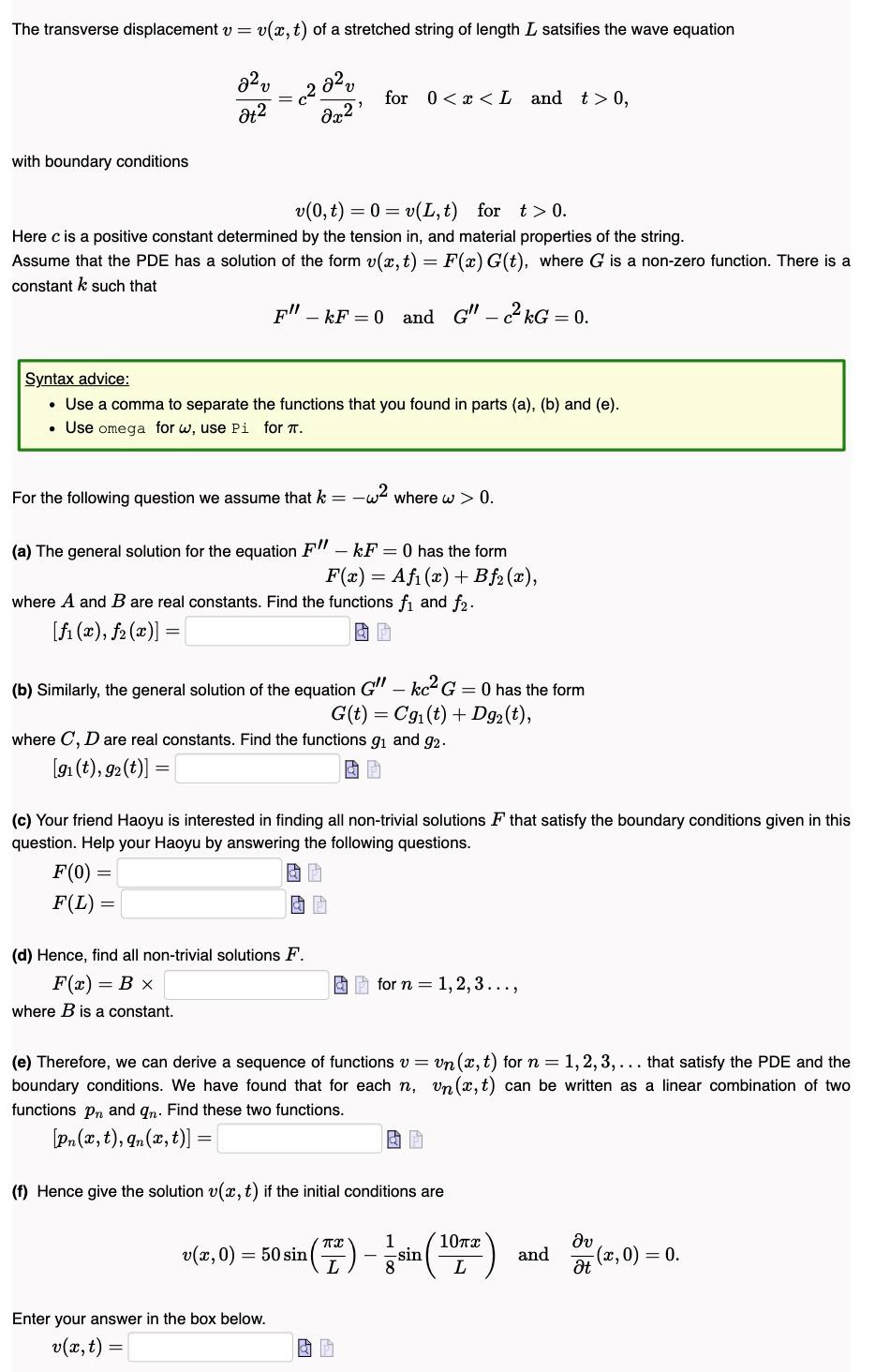Home /
Expert Answers /
Advanced Math /
please-help-me-all-parts-a-b-c-d-e-f-the-transverse-displacement-v-v-x-t-of-a-stretched-s-pa521
(Solved): please help me all parts a,b,c,d,e,f The transverse displacement \( v=v(x, t) \) of a stretched s ...
please help me all parts a,b,c,d,e,f
The transverse displacement \( v=v(x, t) \) of a stretched string of length \( L \) satsifies the wave equation \[ \frac{\partial^{2} v}{\partial t^{2}}=c^{2} \frac{\partial^{2} v}{\partial x^{2}}, \quad \text { for } \quad 00 \] with boundary conditions \[ v(0, t)=0=v(L, t) \quad \text { for } \quad t>0 . \] Here \( c \) is a positive constant determined by the tension in, and material properties of the string. Assume that the PDE has a solution of the form \( v(x, t)=F(x) G(t) \), where \( G \) is a non-zero function. There is a constant \( k \) such that \[ F^{\prime \prime}-k F=0 \text { and } G^{\prime \prime}-c^{2} k G=0 . \] Syntax advice: - Use a comma to separate the functions that you found in parts (a), (b) and (e). - Use omega for \( \omega \), use Pi for \( \pi \). For the following question we assume that \( k=-\omega^{2} \) where \( \omega>0 \). (a) The general solution for the equation \( F^{\prime \prime}-k F=0 \) has the form \[ F(x)=A f_{1}(x)+B f_{2}(x), \] where \( A \) and \( B \) are real constants. Find the functions \( f_{1} \) and \( f_{2} \). \[ \left[f_{1}(x), f_{2}(x)\right]= \] (b) Similarly, the general solution of the equation \( G^{\prime \prime}-k c^{2} G=0 \) has the form \[ G(t)=C g_{1}(t)+D g_{2}(t), \] where \( C, D \) are real constants. Find the functions \( g_{1} \) and \( g_{2} \). \[ \left[g_{1}(t), g_{2}(t)\right]= \] (c) Your friend Haoyu is interested in finding all non-trivial solutions \( F \) that satisfy the boundary conditions given in this question. Help your Haoyu by answering the following questions. \[ \begin{array}{l} F(0)= \\ F(L)= \end{array} \] (d) Hence, find all non-trivial solutions \( F \). \[ F(x)=B \times \quad \text { ? } \quad \text { for } n=1,2,3 \ldots, \] where \( B \) is a constant. (e) Therefore, we can derive a sequence of functions \( v=v_{n}(x, t) \) for \( n=1,2,3, \ldots \) that satisfy the PDE and the boundary conditions. We have found that for each \( n, v_{n}(x, t) \) can be written as a linear combination of two functions \( p_{n} \) and \( q_{n} \). Find these two functions. \[ \left[p_{n}(x, t), q_{n}(x, t)\right]= \] (f) Hence give the solution \( v(x, t) \) if the initial conditions are \[ v(x, 0)=50 \sin \left(\frac{\pi x}{L}\right)-\frac{1}{8} \sin \left(\frac{10 \pi x}{L}\right) \quad \text { and } \quad \frac{\partial v}{\partial t}(x, 0)=0 \] Enter your answer in the box below. \[ v(x, t)= \]
Expert Answer
a) Let us consider that k=??2 where ?>0. Now the general solution for the equation F?+?2F=0has the form F(x)=Acos?(kx)+Bsin?(kx). Comparing this to th
